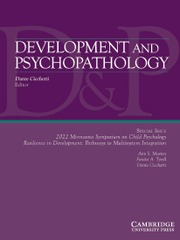No CrossRef data available.
Article contents
Patterns of continuity and discontinuity of childhood maltreatment across generations: A meta-analysis
Published online by Cambridge University Press: 19 May 2025
Abstract
Empirical tests of the “cycle of maltreatment” hypothesis have typically focused on the presence or absence of child maltreatment across generations. However, this narrow focus does not account for diverse intergenerational pathways of maltreatment. This systematic review and meta-analysis synthesizes data to determine the distribution of cycle maintainers, breakers, initiators, and unaffected families (i.e., controls). Of the 65 independent studies (80 samples), 30 examined intergenerational cycles of maltreatment broadly, while 27 reported data for physical abuse, 17 sexual abuse, 5 neglect, and 1 emotional abuse specifically. For maltreatment, 17.1% (95%CI: 12.1%, 22.1%) were cycle maintainers, 23.6% (95%CI: 18.0%, 29.2%) were cycle breakers, 11.4% (95%CI: 7.8%, 15.1%) were cycle initiators and 47.8% (95%CI: 39.7%, 55.9%) controls. Thus, although a parent’s maltreatment history is a risk factor, results suggest that a greater proportion of parents break the cycle of maltreatment versus maintain it. Moderator analyses showed that study design, assessment methods, and demographic characteristics influence maltreatment transmission rates. Intergenerational patterns of physical, sexual, and emotional abuse and neglect are also detailed. Our findings underscore the complexity of intergenerational maltreatment, highlighting the need to explore not only its maintenance but also the protective factors that help break cycles and the risk factors that drive its initiation.
Information
- Type
- Regular Article
- Information
- Copyright
- © The Author(s), 2025. Published by Cambridge University Press


